Hottentot's Holland - Paradise Lost
Quote from Steve on September 30, 2025, 3:50 pm
1805. Khoi engaged in roasting grasshoppers.
Aquatint by Samuel Daniell idealises Kora Khoi as 'noble savages' during the last year of Dutch rule.When European seamen first landed on the southern shores of Africa in 1488 communication with its people was difficult. The Khoikhoi, (previously known as 'Hottentots'), spoke a language unlike anything anyone had heard before. It was only possible to communicate with them by making hand-signs and by imitating the mooing of cows and the baahing of sheep that the Europeans wanted in exchange for bits of metal. These encounters left neither side any the wiser as to who the other was.
Perhaps the one thing that the Khoi were certain about was that they did not like the look and sound of these ugly, bearded, filthy, smelly pale men with poor teeth who had arrived as uninvited interlopers from the sea. While the Portuguese used the term 'Kaffir' which they had learned from the Arabs to describe Black African and other non-Muslim people, neither they nor other early visitors to the Cape used the term 'Hottentot' to describe its people. Before 1652 travellers to the Cape referred to its occupants as 'people', 'inhabitants', 'natives' and 'Negroes', also 'Beasts', 'Caffres', 'Savages', even 'Troglodytes'. The word 'Hottentot' would not come into common use for about another 150 years.
Its first use was in 1652 in a small tract published in Amsterdam that was devoted entirely to a description of the Cape of Good Hope . Entitled 'Klare ende Korte Besgryvinge van het Land aan Cabo de Bona Esperanca', (Dutch. 'A Clear and Concise Description of the Lands of the Cape of Good Hope'), it was a compilation of articles and accounts of the Cape given by travellers and seamen. It provides the first and earliest attested European use of 'Hottentot' to appear in print. Curiously, in the same year, the Dutch Commander at the Cape, Jan van Riebeeck, made the first South African reference to the Peninsula's indigenous people as 'Hottentots' in his Journal.
Our thanks to 'Herrie van der Spiegel' for this instructive page from his 'History of South Africa'.
The term 'Hottentot' came into colloquial use by the Dutch and maybe some others just before van Riebeeck's arrival at the Cape in 1652. After European settlement began the term was widely and exclusively used by the colonists as the name for the local non-Bantu people. The Dutch would use 'Hottentot' for almost 150 years and pass it on to the British who would think nothing of using it and 'Kaffir'. While we know the Islamic origins of 'kaffir', the exact etymology of 'Hottentot' remains debated among scholars. Some say it derives from a Dutch imitation of the Khoikhoi's language, possibly mimicking the sound of their speech. No, there's a better explanation.
The VOC (Dutch East India Company) were the world's first multi-national trading company with huge commercial interests, mostly in south-east Asia. This enterprise needed hundreds of ships and 1000s of men to sail them. Before 1652 mortality rates of 25% to 50% or more were not uncommon among crewmen due to disease, shipwreck, war, incompetence and piracy. It has been estimated that asmany as 900,000 Dutchmen were lost colonising Batavia. Holland could not sustain such losses. As a result, the VOC began to look for fresh recruits beyond Holland and found willing applicants in northern Europe and Scandanavia. Many Germans joined the VOC as sailors and soldiers. They saw the VOC as an opportunity to escape poverty and serfdom in a semi-feudal Europe.
I assume that on arriving at the Cape with a Dutch fleet one such German heard the utterly unusual Khoi language for the first time. He probably laughed and said that it sounded to him like 'hottentotteren'. This is an archaic German word for 'stuttering'. The description was amusing and it was picked up by other sailors who used it. It spread across the fleet. The Khoi had become 'stutterers'. Hottentots!.
The VOC did not occupy the Cape to exploit its bounty. It had no established civilization of fine buildings to house great princes eager to trade. It had neither gold, silver, silks, gems, porcelain nor perfume, just the Khoi, semi-nomadic pastoralists who raised cattle, sheep, and goats, moving their herds seasonally to find grazing land.. The VOC saw the Cape simply as a replenishment station to feed their scurvy-ridden trading fleets on which the fortunes of Holland depended. The VOC believed that the Khoi would want to trade cattle with them. Why wouldn't they? Well, because by 1652 the Khoi had all the scrap metal and copper and brass hoops they needed. They were reluctant to trade anymore of their wealth, their cattle. They did not welcome the VOC's self-imposed, uninvited presence.
1805. Early SA Campers in Paradise. The Khoi preparing to move camp.
Aquatint by Samuel Daniell idealises Kora Khoi as 'noble savages' during the last year of Dutch rule.After building a damp and primitive sod and timber 'fort', the Dutch sent an expedition into the interior with the aim of locating the Khoi and trading for cattle. After struggling across the sandy Cape Flats they encountered a large Khoi camp in the area of today's Somerset West. When the Dutch asked them what this fertle place was called, the Khoi replied "it is our Holland" (ie. "it is our land, not yours!"). Over time this area of the outer Cape Peninsula would become known as the 'Hottentot's Holland'.
The Khoi began to see the Dutch as a threat and withdrew their labour, ceased trading their livestock, the measure of their wealth, and finally attacked the Dutch in winter when their matchlocks were unreliable in the rain. This was not the simple 'win-win' scenario that the Dutch had anticipated. Unable to gain the support of the Khoi the Dutch freed some of their indentured employees and allowed them to become farmers. This decision inadvertently unlocked the Cape's potential for European settlement and colonisation.
A combination of war and later disease saw the Khoi lose cattle and land to the Dutch farmers or Boers who with each generation trekked outward looking for more farmland. The Europeans and the Khoi maintained an uneasy relationship until 1713 when a devastating smallpox epidemic destroyed the Khoi clans and their society. Europeans also died as a result of the outbreak which arrived on an infected ship from India but their exposure to diseases of the 'Old World' gave them with more protection. The remnants of the Khoi now begged the Boers (Dutch. farmers) to let them live on the margins of their farms as 'servants'
1907. Postcard. 'Bushman (100 years old)'. Unlikely.
This man may be Khoi or San, certainly Khoisan.
The ill-fitting cast-off clothes indicate a life lived on the margins since childhood.Both the Dutch and British colonies were centred on the interests of 'Europeans' with the Khoi relegated to a third class status, a free people no better than the slaves. Some Khoi groups tried to preserve their way of life by taking refuge in places as yet untouched by colonial law. Among the now mixed race Khoi groups escaping Dutch colonial rule were the Griqua, who trekked from the Cape 50 years before the Boers left the British, and the Nama who entered southern Namibia. Both crossed the Gariep (Khoi. the Orange River) in an attempt to resurrect Khoi culture and live under their own laws free from colonial interference.
Today the gratuitous use of the word 'Hottentot' is verboten in the ANC's woke SA. When I am in Cape Town and I look across the Cape Flats to the mountians in the distance I think of them as the fabled "Hottentot's Holland" because that is what it was called when I was a child. There is no race hatred in my use of this name. Nevertheless, I can understand that today some people want to be called Khoi rather than 'Hottentot'. From my own experience I recall that when 'Hottentot' is corrupted to 'hotnot' or 'hottie' to describe people, usually with real race hatred, it is deeply racist and offensive. Such use should be and is now outlawed.
Not all use of 'Hottentot' has been discarded. The old colonial-era name of 'Hottentots Holland' continue to be used to describe a region around Somerset West in the Western Cape. It also survives in the ongoing use of my Hottentots Holland Mountains which lie just east of Cape Town across the Cape Flats near the towns of Somerset West. Grabouw and Stellenbosch. The name is also remembered in the 'Hottentots Holland Nature Reserve', a place of outstanding natural beauty and fynbos vegetation.
A Hottentots Holland post office was established in 1823. According to Ralph Putzel's 'Encyclopedia of SA Post Offices and Postal Agencies' the first postmaster was H. R. Vos on an annual salary of £7 10/-. An Octagonal Numeral obliterator was supplied to the Hottentot's Holland Post Office in "* * 1850", according to Franco Frescura and Alex Visser (Post Offices and Postal Markings of the Cape of Good Hope 1792 - 1910). Its DTO (Dated Town Oval) was first seen on 21 AP 1853 and last recorded on 4 JY 1876.
Cape Triangular stamps were introduced in 1853, the first rectangles in 1864. The Triangular Obliterator assigned to the Hottentot's Holland Post Office was first seen 24 April 1857 and last recorde4d 29 OC 1901. The name of the Hottentot's Holland Post Office was changed to Somerset West "in 1865", (Ralph Putzel. 'The Postmarks of South Africa'.), "but old date stamp continued". Covers show the HOTTENTOTS HOLLAND DTO datestamp continuing to be used to cancel rectangles long after the Post Office's name change.
The cover below is illustrated in Putzel's 'The Postmarks of South Africa'. It is a variety with manuscript 10 (day) in the DTO.This classic cover was previously in the possession of Robert Goldblatt, (The Postmarks of the Cape of Good Hope.)
1870. Same day cover. HOTTENTOTS HOLLAND 'NO 10 1870' via ERSTE RIVER STATION to STELLENBOSCH.
The day slug in the date was missing, necessitating the insertion of a manuscript '10'.
Two covers shown by Putzel reveal that the day slug was in place in 1869 and 1875.
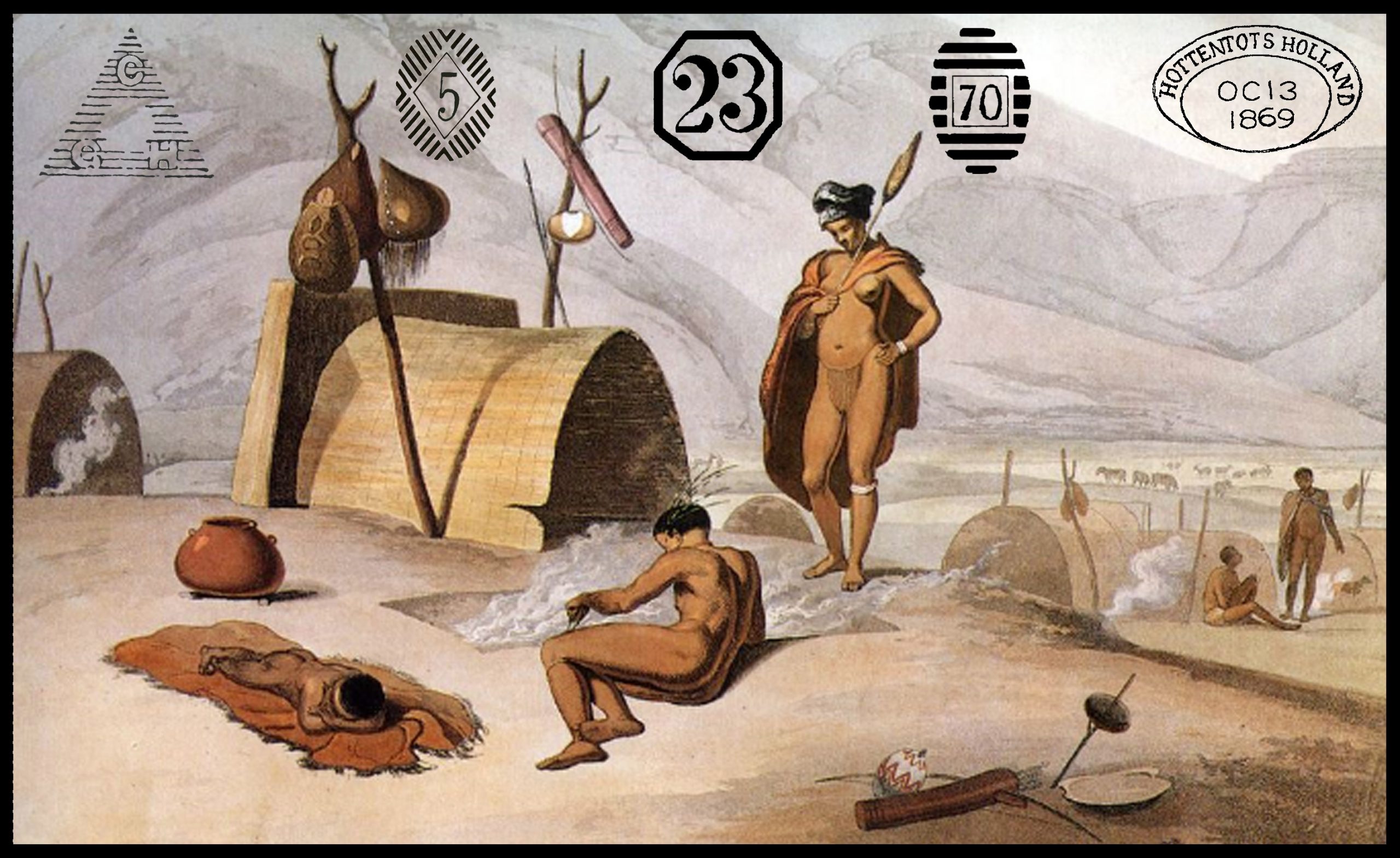
1805. Khoi engaged in roasting grasshoppers.
Aquatint by Samuel Daniell idealises Kora Khoi as 'noble savages' during the last year of Dutch rule.
When European seamen first landed on the southern shores of Africa in 1488 communication with its people was difficult. The Khoikhoi, (previously known as 'Hottentots'), spoke a language unlike anything anyone had heard before. It was only possible to communicate with them by making hand-signs and by imitating the mooing of cows and the baahing of sheep that the Europeans wanted in exchange for bits of metal. These encounters left neither side any the wiser as to who the other was.
Perhaps the one thing that the Khoi were certain about was that they did not like the look and sound of these ugly, bearded, filthy, smelly pale men with poor teeth who had arrived as uninvited interlopers from the sea. While the Portuguese used the term 'Kaffir' which they had learned from the Arabs to describe Black African and other non-Muslim people, neither they nor other early visitors to the Cape used the term 'Hottentot' to describe its people. Before 1652 travellers to the Cape referred to its occupants as 'people', 'inhabitants', 'natives' and 'Negroes', also 'Beasts', 'Caffres', 'Savages', even 'Troglodytes'. The word 'Hottentot' would not come into common use for about another 150 years.
Its first use was in 1652 in a small tract published in Amsterdam that was devoted entirely to a description of the Cape of Good Hope . Entitled 'Klare ende Korte Besgryvinge van het Land aan Cabo de Bona Esperanca', (Dutch. 'A Clear and Concise Description of the Lands of the Cape of Good Hope'), it was a compilation of articles and accounts of the Cape given by travellers and seamen. It provides the first and earliest attested European use of 'Hottentot' to appear in print. Curiously, in the same year, the Dutch Commander at the Cape, Jan van Riebeeck, made the first South African reference to the Peninsula's indigenous people as 'Hottentots' in his Journal.
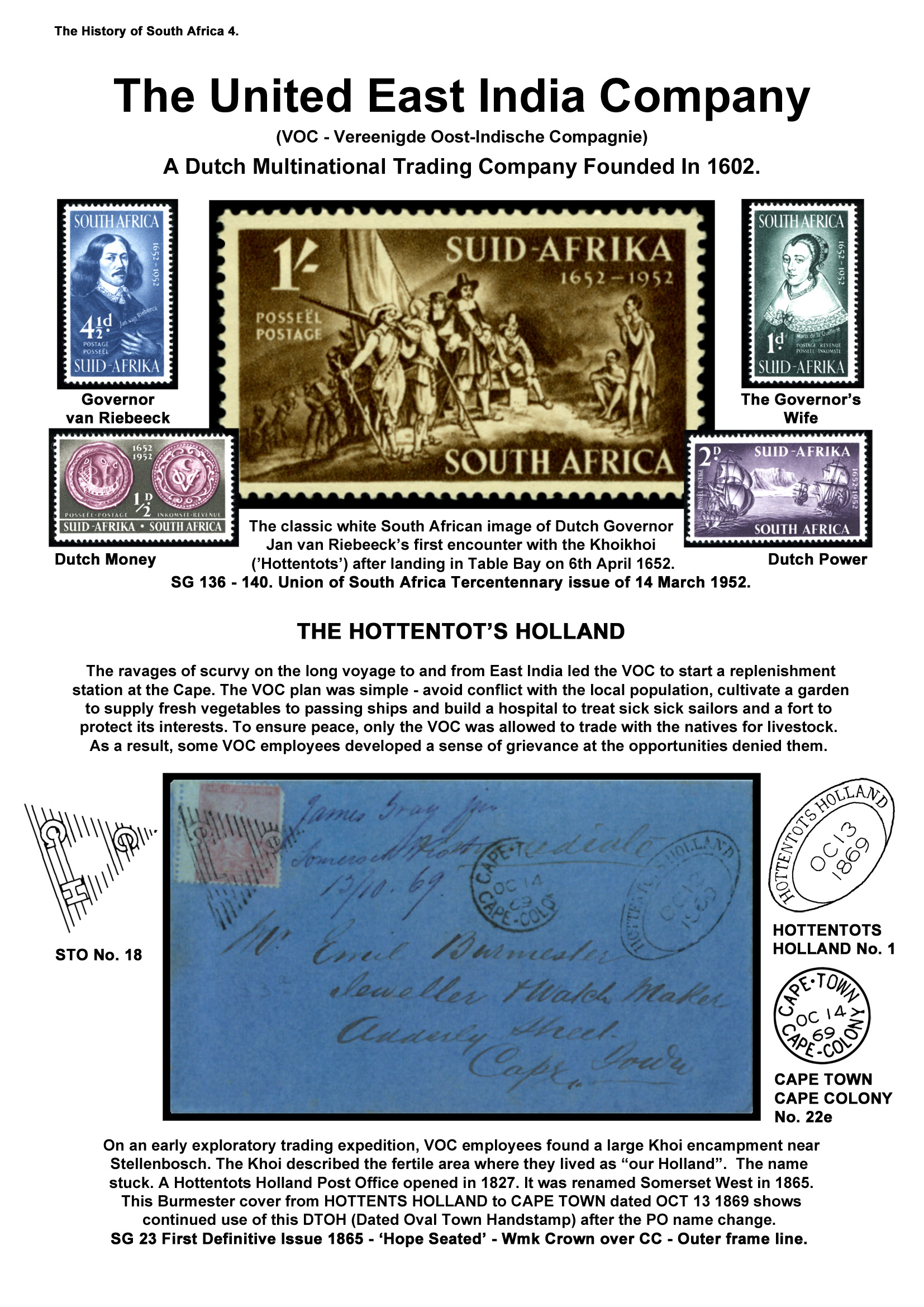
Our thanks to 'Herrie van der Spiegel' for this instructive page from his 'History of South Africa'.
The term 'Hottentot' came into colloquial use by the Dutch and maybe some others just before van Riebeeck's arrival at the Cape in 1652. After European settlement began the term was widely and exclusively used by the colonists as the name for the local non-Bantu people. The Dutch would use 'Hottentot' for almost 150 years and pass it on to the British who would think nothing of using it and 'Kaffir'. While we know the Islamic origins of 'kaffir', the exact etymology of 'Hottentot' remains debated among scholars. Some say it derives from a Dutch imitation of the Khoikhoi's language, possibly mimicking the sound of their speech. No, there's a better explanation.
The VOC (Dutch East India Company) were the world's first multi-national trading company with huge commercial interests, mostly in south-east Asia. This enterprise needed hundreds of ships and 1000s of men to sail them. Before 1652 mortality rates of 25% to 50% or more were not uncommon among crewmen due to disease, shipwreck, war, incompetence and piracy. It has been estimated that asmany as 900,000 Dutchmen were lost colonising Batavia. Holland could not sustain such losses. As a result, the VOC began to look for fresh recruits beyond Holland and found willing applicants in northern Europe and Scandanavia. Many Germans joined the VOC as sailors and soldiers. They saw the VOC as an opportunity to escape poverty and serfdom in a semi-feudal Europe.
I assume that on arriving at the Cape with a Dutch fleet one such German heard the utterly unusual Khoi language for the first time. He probably laughed and said that it sounded to him like 'hottentotteren'. This is an archaic German word for 'stuttering'. The description was amusing and it was picked up by other sailors who used it. It spread across the fleet. The Khoi had become 'stutterers'. Hottentots!.
The VOC did not occupy the Cape to exploit its bounty. It had no established civilization of fine buildings to house great princes eager to trade. It had neither gold, silver, silks, gems, porcelain nor perfume, just the Khoi, semi-nomadic pastoralists who raised cattle, sheep, and goats, moving their herds seasonally to find grazing land.. The VOC saw the Cape simply as a replenishment station to feed their scurvy-ridden trading fleets on which the fortunes of Holland depended. The VOC believed that the Khoi would want to trade cattle with them. Why wouldn't they? Well, because by 1652 the Khoi had all the scrap metal and copper and brass hoops they needed. They were reluctant to trade anymore of their wealth, their cattle. They did not welcome the VOC's self-imposed, uninvited presence.
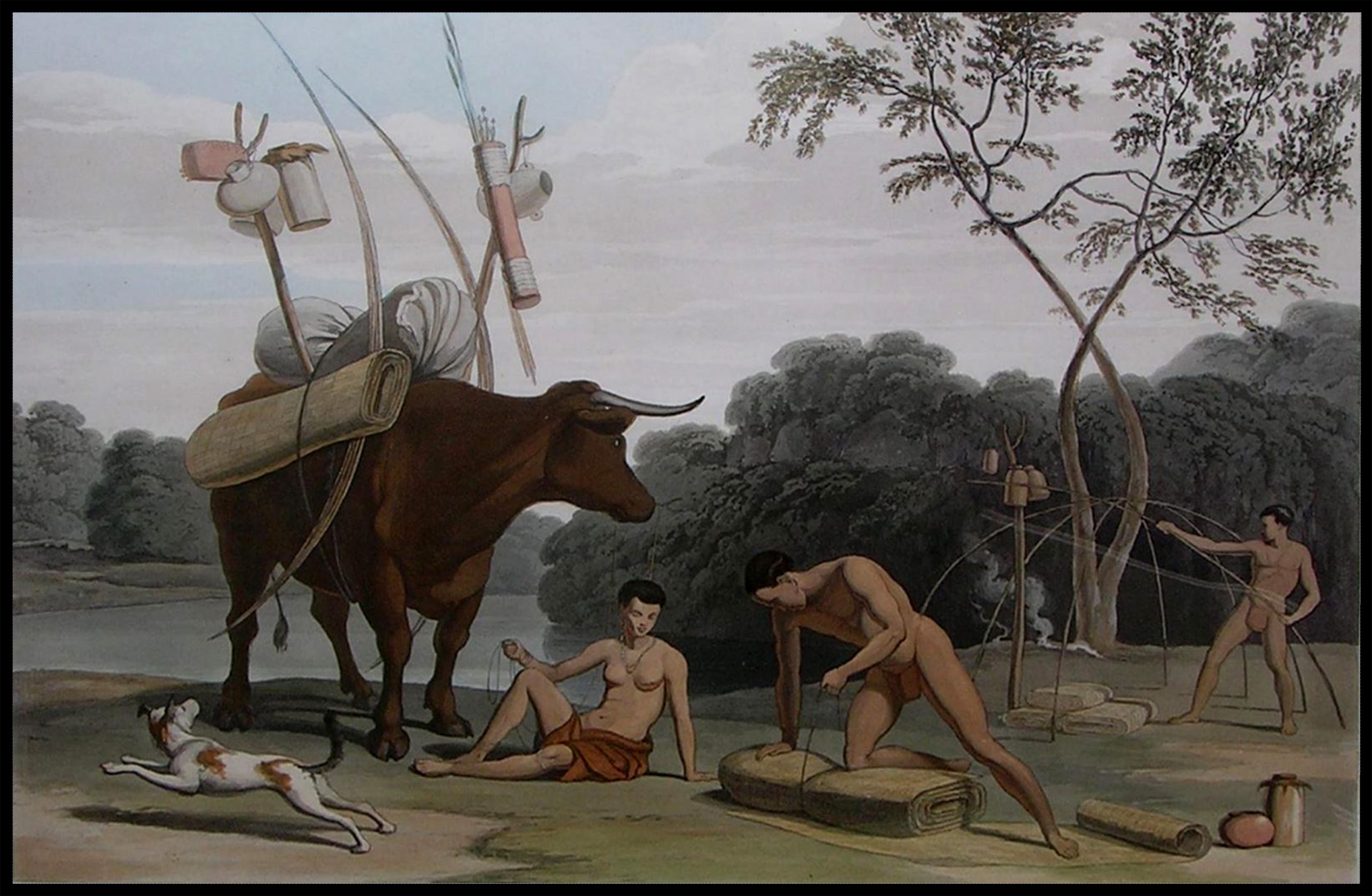
1805. Early SA Campers in Paradise. The Khoi preparing to move camp.
Aquatint by Samuel Daniell idealises Kora Khoi as 'noble savages' during the last year of Dutch rule.
After building a damp and primitive sod and timber 'fort', the Dutch sent an expedition into the interior with the aim of locating the Khoi and trading for cattle. After struggling across the sandy Cape Flats they encountered a large Khoi camp in the area of today's Somerset West. When the Dutch asked them what this fertle place was called, the Khoi replied "it is our Holland" (ie. "it is our land, not yours!"). Over time this area of the outer Cape Peninsula would become known as the 'Hottentot's Holland'.
The Khoi began to see the Dutch as a threat and withdrew their labour, ceased trading their livestock, the measure of their wealth, and finally attacked the Dutch in winter when their matchlocks were unreliable in the rain. This was not the simple 'win-win' scenario that the Dutch had anticipated. Unable to gain the support of the Khoi the Dutch freed some of their indentured employees and allowed them to become farmers. This decision inadvertently unlocked the Cape's potential for European settlement and colonisation.
A combination of war and later disease saw the Khoi lose cattle and land to the Dutch farmers or Boers who with each generation trekked outward looking for more farmland. The Europeans and the Khoi maintained an uneasy relationship until 1713 when a devastating smallpox epidemic destroyed the Khoi clans and their society. Europeans also died as a result of the outbreak which arrived on an infected ship from India but their exposure to diseases of the 'Old World' gave them with more protection. The remnants of the Khoi now begged the Boers (Dutch. farmers) to let them live on the margins of their farms as 'servants'
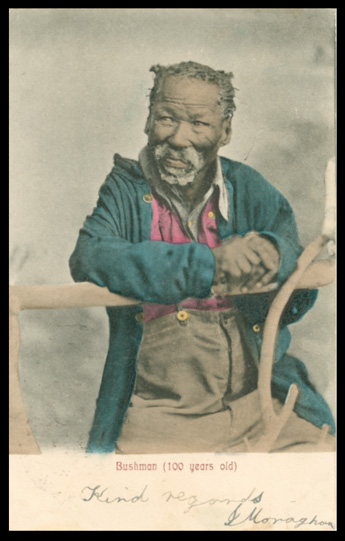
1907. Postcard. 'Bushman (100 years old)'. Unlikely.
This man may be Khoi or San, certainly Khoisan.
The ill-fitting cast-off clothes indicate a life lived on the margins since childhood.
Both the Dutch and British colonies were centred on the interests of 'Europeans' with the Khoi relegated to a third class status, a free people no better than the slaves. Some Khoi groups tried to preserve their way of life by taking refuge in places as yet untouched by colonial law. Among the now mixed race Khoi groups escaping Dutch colonial rule were the Griqua, who trekked from the Cape 50 years before the Boers left the British, and the Nama who entered southern Namibia. Both crossed the Gariep (Khoi. the Orange River) in an attempt to resurrect Khoi culture and live under their own laws free from colonial interference.
Today the gratuitous use of the word 'Hottentot' is verboten in the ANC's woke SA. When I am in Cape Town and I look across the Cape Flats to the mountians in the distance I think of them as the fabled "Hottentot's Holland" because that is what it was called when I was a child. There is no race hatred in my use of this name. Nevertheless, I can understand that today some people want to be called Khoi rather than 'Hottentot'. From my own experience I recall that when 'Hottentot' is corrupted to 'hotnot' or 'hottie' to describe people, usually with real race hatred, it is deeply racist and offensive. Such use should be and is now outlawed.
Not all use of 'Hottentot' has been discarded. The old colonial-era name of 'Hottentots Holland' continue to be used to describe a region around Somerset West in the Western Cape. It also survives in the ongoing use of my Hottentots Holland Mountains which lie just east of Cape Town across the Cape Flats near the towns of Somerset West. Grabouw and Stellenbosch. The name is also remembered in the 'Hottentots Holland Nature Reserve', a place of outstanding natural beauty and fynbos vegetation.
A Hottentots Holland post office was established in 1823. According to Ralph Putzel's 'Encyclopedia of SA Post Offices and Postal Agencies' the first postmaster was H. R. Vos on an annual salary of £7 10/-. An Octagonal Numeral obliterator was supplied to the Hottentot's Holland Post Office in "* * 1850", according to Franco Frescura and Alex Visser (Post Offices and Postal Markings of the Cape of Good Hope 1792 - 1910). Its DTO (Dated Town Oval) was first seen on 21 AP 1853 and last recorded on 4 JY 1876.
Cape Triangular stamps were introduced in 1853, the first rectangles in 1864. The Triangular Obliterator assigned to the Hottentot's Holland Post Office was first seen 24 April 1857 and last recorde4d 29 OC 1901. The name of the Hottentot's Holland Post Office was changed to Somerset West "in 1865", (Ralph Putzel. 'The Postmarks of South Africa'.), "but old date stamp continued". Covers show the HOTTENTOTS HOLLAND DTO datestamp continuing to be used to cancel rectangles long after the Post Office's name change.
The cover below is illustrated in Putzel's 'The Postmarks of South Africa'. It is a variety with manuscript 10 (day) in the DTO.This classic cover was previously in the possession of Robert Goldblatt, (The Postmarks of the Cape of Good Hope.)
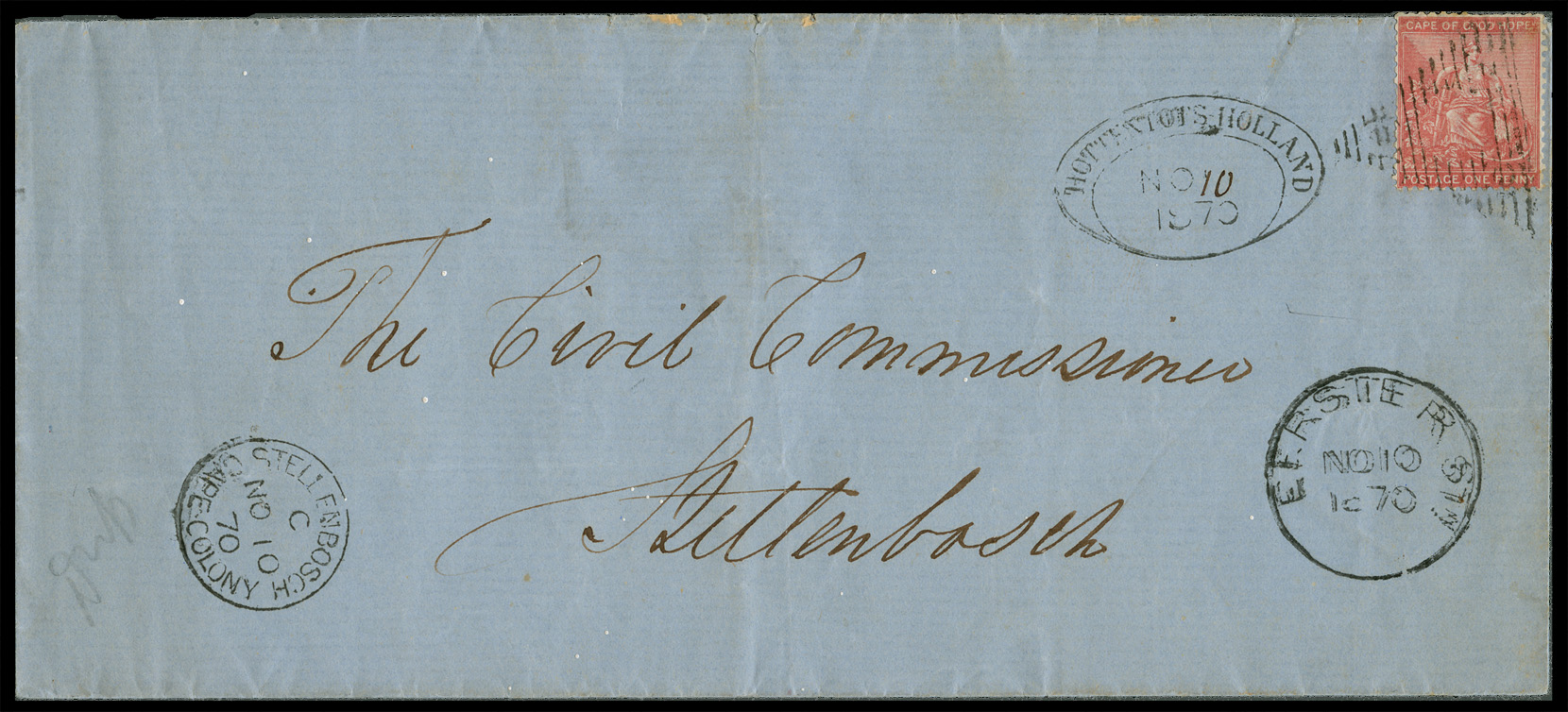
1870. Same day cover. HOTTENTOTS HOLLAND 'NO 10 1870' via ERSTE RIVER STATION to STELLENBOSCH.
The day slug in the date was missing, necessitating the insertion of a manuscript '10'.
Two covers shown by Putzel reveal that the day slug was in place in 1869 and 1875.
Quote from dncom@mweb.co.za on September 30, 2025, 5:25 pmGreat write-up of the history!
Great write-up of the history!
Quote from Steve on October 1, 2025, 11:56 amThanks. It is encouraging to get some feedback. Jamie and I appreciate it. We live philatelically for such moments.
The Hottentot's Holland region includes Somerset West, originally just 'Somerset'. This conflicted with Somerset East, necessitating the addition of 'West'. Interestingly, these changes were done at the behest of a confused Post Office. The Strand, Grabouw and Stellenbosch area also included in the region. Here are a few covers from these towns, starting with another Hottentots Holland (Somerset) DTO.
1873. Cover. HOTTENTOTS HOLLAND 'AP 30 1873' to STELLENBOSCH 'AP 30 73'.
A pair of 1d red paying a double rate of Penny Post, cancelled with a triangular obliterator.
A Stellenbosch single circle arrival datestamp shows same day delivery, typical of local Penny Post.As Stellenbosch was the first town to be founded outside the Dutch settlement below Table Mountain, it has had a connection to the Cape Post Office for as long as one has existed in South Africa. Founded in 1679 by Governor Simon van der Stel and named after him (Dutch. Stel's Forest). The French Huguenots, who arrived in the 1680s, played a key role in establishing a long-flourishing wine industry. Stellenbosch became a Drostdy (Dutch. a magistracy), developing as an important agricultural settlement with a mixed population of European settlers, slaves and indigenous Khoi. Known today for its preserved Cape Dutch architecture, it is a center of Afrikaans culture and learning. It is the home of a prestigious university whose playing fields make South African rugby a mighty force for positive change in a broken and divided country betrayed by corrupt and incompetent politicians.
1823. Cover. CAPE TOWN '7 MR 7 1823' to STELLENBOSCH.
1878. Cover. STELLENBOSCH 'JU 24 78' to CAPE TOWN 'JU 24 x8'.
A single 1d red paying a the Penny Post rate, cancelled with BONC 13, a proving piece.
A Cape Town single circle arrival datestamp shows same day delivery, typical of local Penny Post.
1906. Postcard. 'Hawequas Mountain - Wellington'.
Wellington is 25 miles from Stellenbosch, the north-west edge of the Hottentots Holland area.
I include this postcard only because the name 'Hawequas' is almost certainly Khoi in origin.At the diagonally opposite end of the Hottentots Holland area is Grabouw, most famous for its boerewors, now a named brand available in many South African supermarkets. On our weekend and or camping trips to Hermanus we would stop off in leafy Grabouw to buy boerwors for our braais. You can live well on its boerwors and Hermanus' fish, milk and honey. This area was indeed a paradise.
1878. Cover. GRABOUW 'AU 25 84' to CAPE TOWN.
A single 2d bistre paying the non-Penny Post rate, cancelled with a triangular obliterator.
Thanks. It is encouraging to get some feedback. Jamie and I appreciate it. We live philatelically for such moments.
The Hottentot's Holland region includes Somerset West, originally just 'Somerset'. This conflicted with Somerset East, necessitating the addition of 'West'. Interestingly, these changes were done at the behest of a confused Post Office. The Strand, Grabouw and Stellenbosch area also included in the region. Here are a few covers from these towns, starting with another Hottentots Holland (Somerset) DTO.
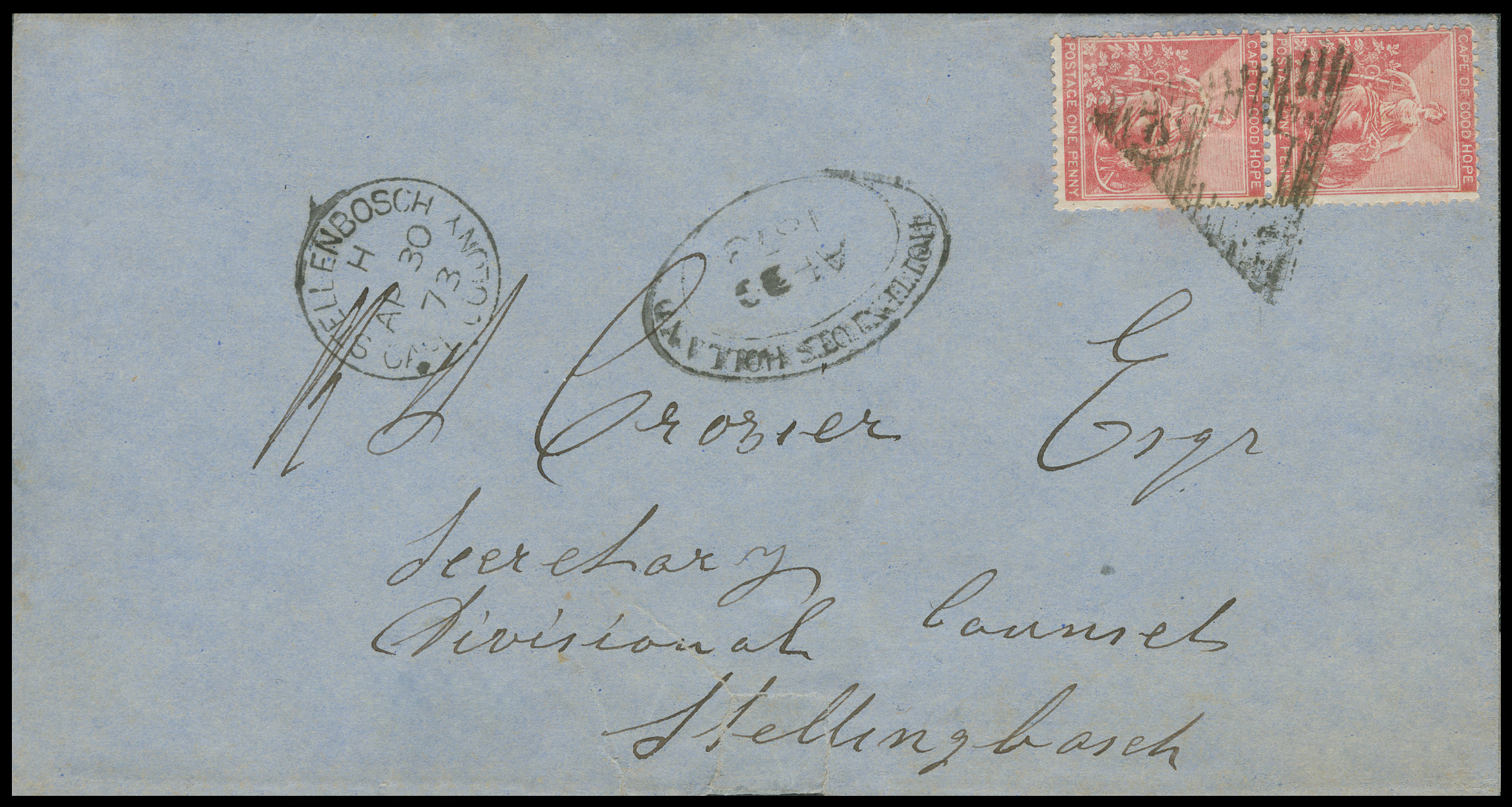
1873. Cover. HOTTENTOTS HOLLAND 'AP 30 1873' to STELLENBOSCH 'AP 30 73'.
A pair of 1d red paying a double rate of Penny Post, cancelled with a triangular obliterator.
A Stellenbosch single circle arrival datestamp shows same day delivery, typical of local Penny Post.
As Stellenbosch was the first town to be founded outside the Dutch settlement below Table Mountain, it has had a connection to the Cape Post Office for as long as one has existed in South Africa. Founded in 1679 by Governor Simon van der Stel and named after him (Dutch. Stel's Forest). The French Huguenots, who arrived in the 1680s, played a key role in establishing a long-flourishing wine industry. Stellenbosch became a Drostdy (Dutch. a magistracy), developing as an important agricultural settlement with a mixed population of European settlers, slaves and indigenous Khoi. Known today for its preserved Cape Dutch architecture, it is a center of Afrikaans culture and learning. It is the home of a prestigious university whose playing fields make South African rugby a mighty force for positive change in a broken and divided country betrayed by corrupt and incompetent politicians.
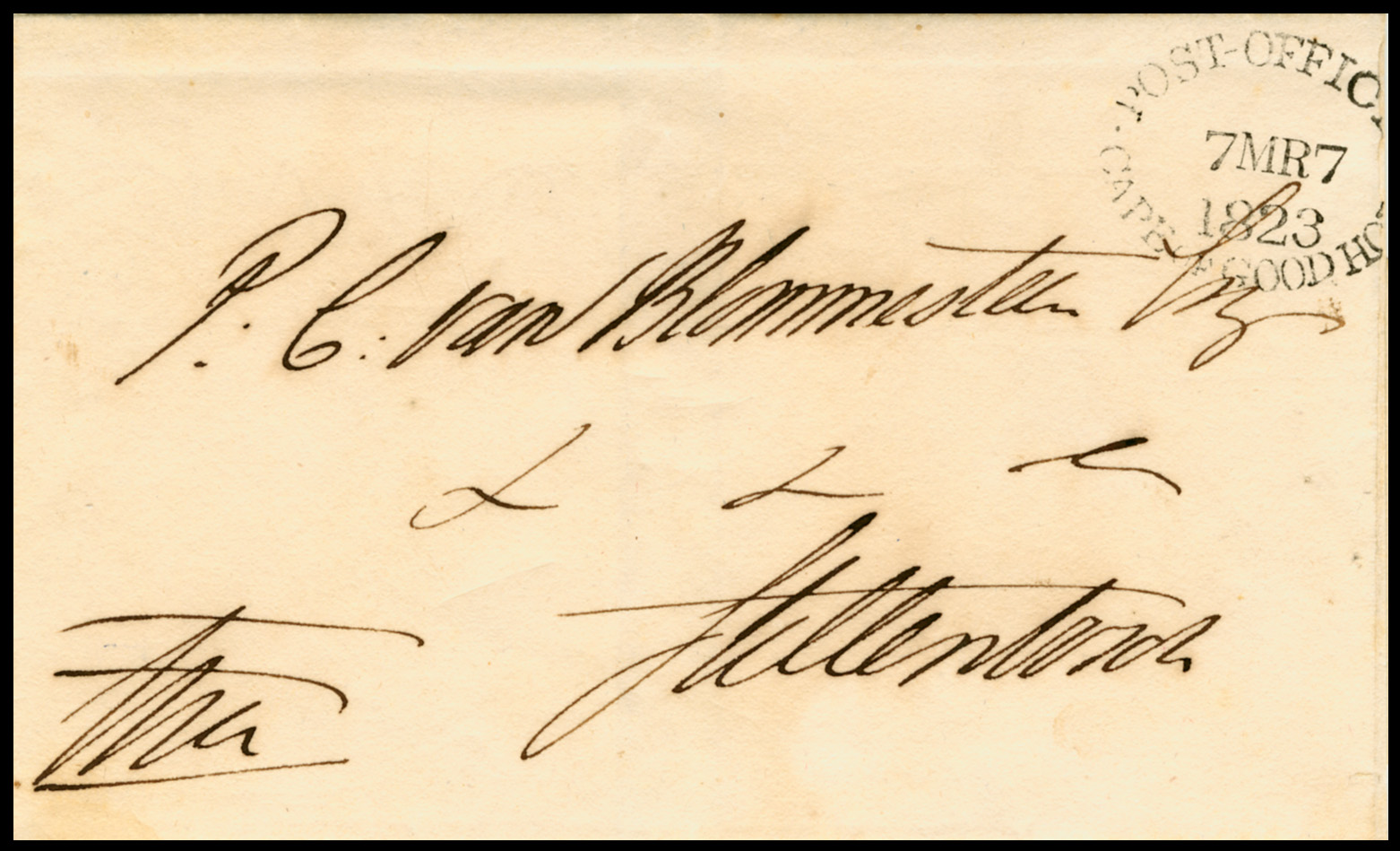
1823. Cover. CAPE TOWN '7 MR 7 1823' to STELLENBOSCH.
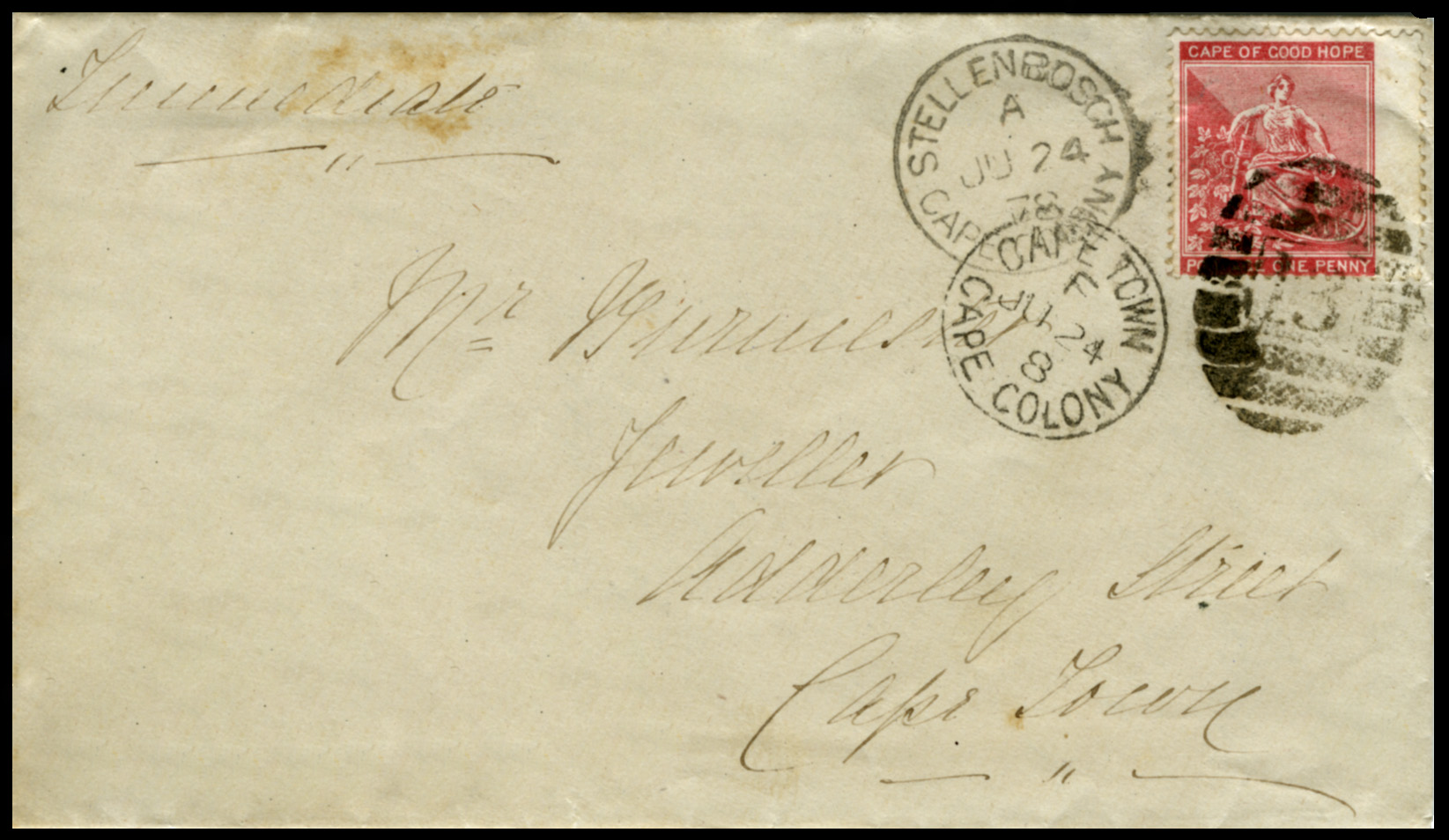
1878. Cover. STELLENBOSCH 'JU 24 78' to CAPE TOWN 'JU 24 x8'.
A single 1d red paying a the Penny Post rate, cancelled with BONC 13, a proving piece.
A Cape Town single circle arrival datestamp shows same day delivery, typical of local Penny Post.
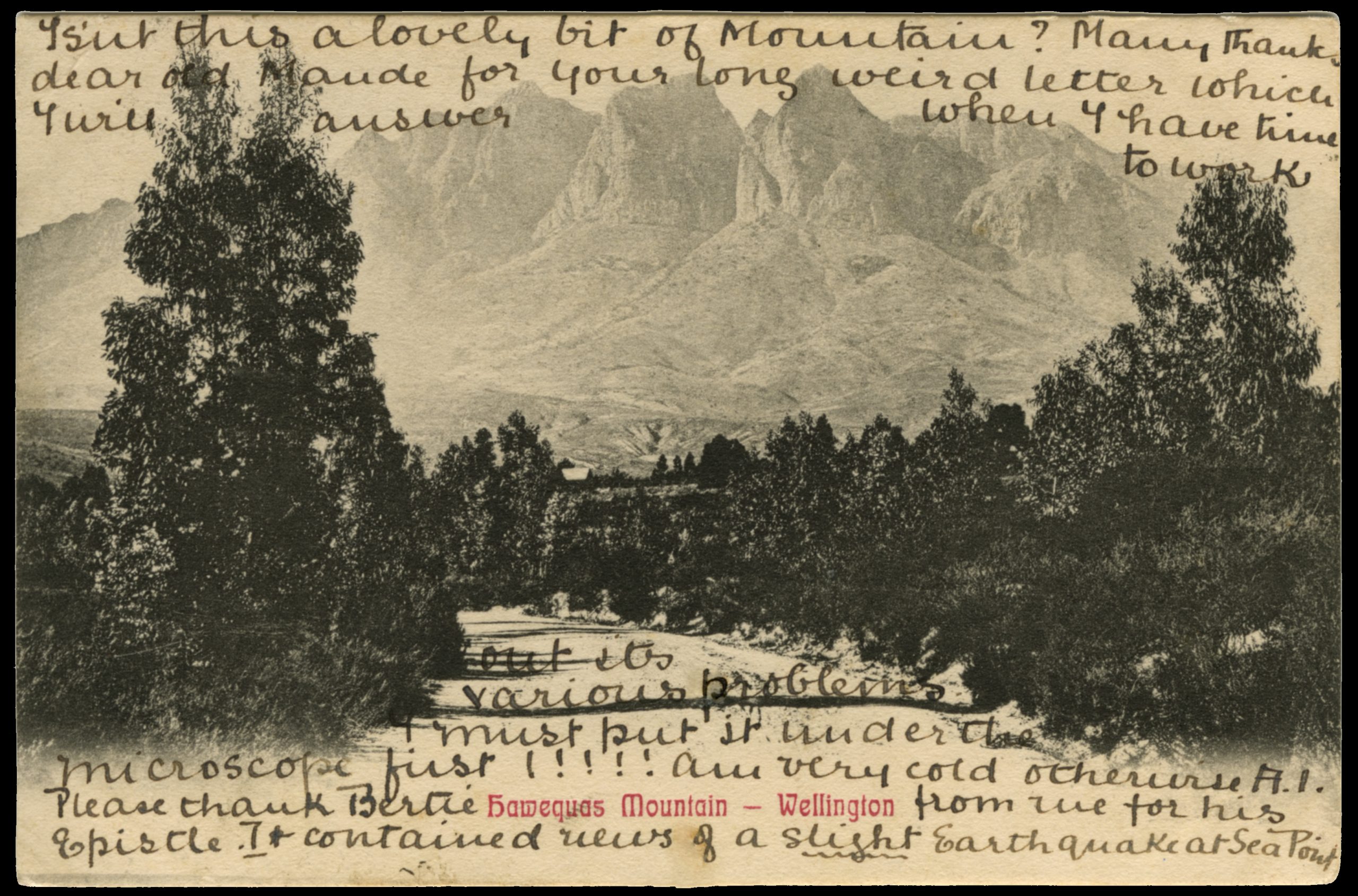
1906. Postcard. 'Hawequas Mountain - Wellington'.
Wellington is 25 miles from Stellenbosch, the north-west edge of the Hottentots Holland area.
I include this postcard only because the name 'Hawequas' is almost certainly Khoi in origin.
At the diagonally opposite end of the Hottentots Holland area is Grabouw, most famous for its boerewors, now a named brand available in many South African supermarkets. On our weekend and or camping trips to Hermanus we would stop off in leafy Grabouw to buy boerwors for our braais. You can live well on its boerwors and Hermanus' fish, milk and honey. This area was indeed a paradise.
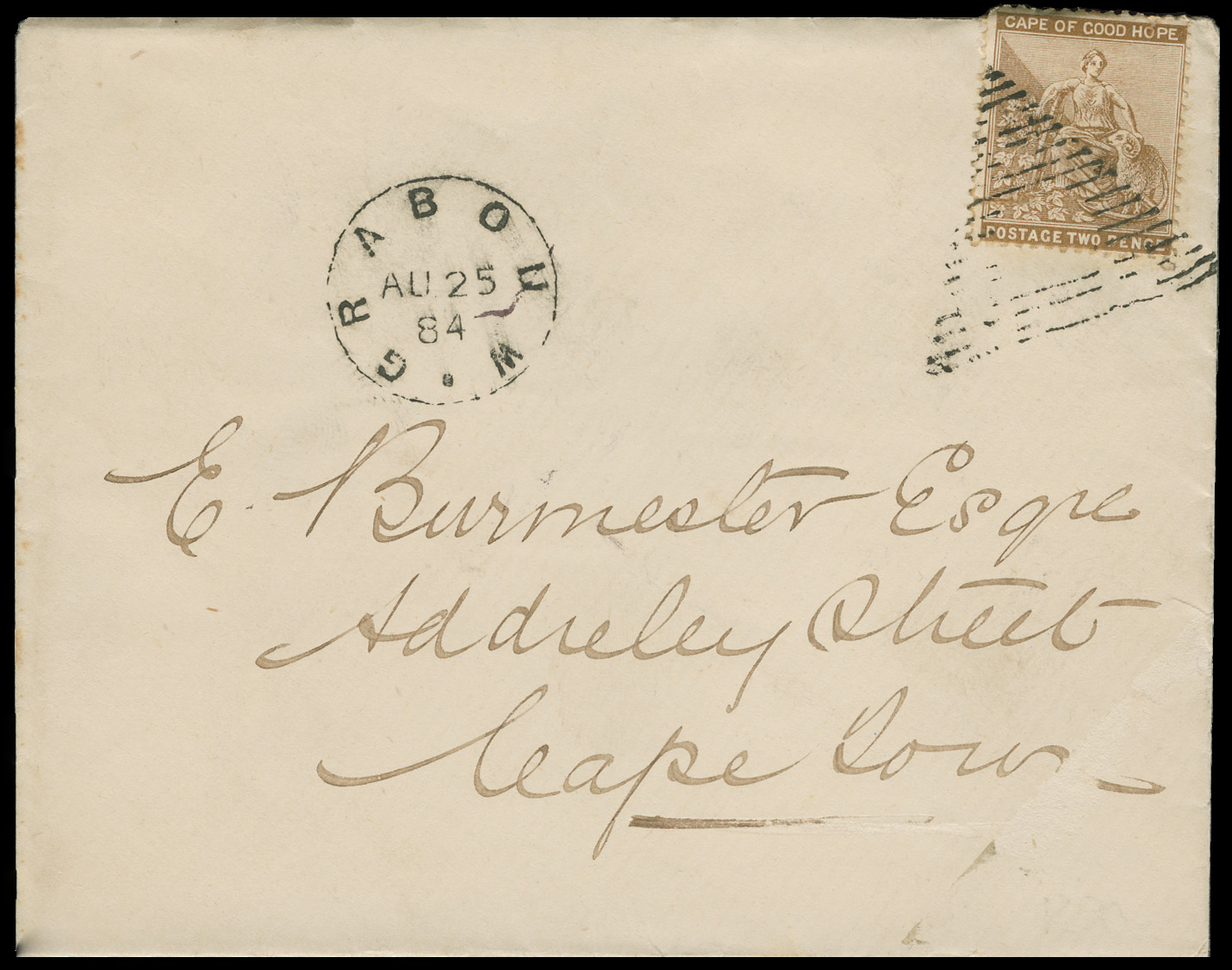
1878. Cover. GRABOUW 'AU 25 84' to CAPE TOWN.
A single 2d bistre paying the non-Penny Post rate, cancelled with a triangular obliterator.
Quote from Steve on October 3, 2025, 10:11 amConfusingly, there are two 'Somersets' in the Cape. Lord Charles Somerset, Governor of the Cape, (1814–1826), founded a tobacco farm in the Eastern Cape. It was supplied with the SOMERSET CiC (Crown in Circle) handstamp in 1823. (Goldblatt.) When this venture failed the town of Somerset East was founded on the farm in 1825.
Somerset West was also named in honor of Lord Charles Somerest. However, the town was already a church-based community settlement in the district of Stellenbosch, (Hottentot's Holland). by the time he became governor. As Governor, Somerset approved its formal naming in 1822, (Dictionary of South African Biography). To create a distinction with the other 'Somerset', this town was called 'Somerset West. The reference books are not exactly clear on the how, why and when of these two towns' founding and naming.
If any of this is wrong, I welcome your corrections, please.
Circa. 1940. Cigarette Card. Lord Charles Somerset, Governor of the Cape, 1814 - 1826.
The following cover has little to do with the 'Hottentot's Holland' but everything to do with the Governor of the Cape of Good Hope in 1823, very much the time that Somerset West came into being in the district of Stellenbosch, (Hottentot's Holland).
1823. Cover. GRAHAMSTOWN (large CiC handstamp) to CAPE TOWN 'OC 31 1823'.
As this is official and addressed to the Governor, it has been accepted as 'FREE' of charge.
It has received an early, sharp strike of the first 'FREE' datestamp (intoduced 1823).
Confusingly, there are two 'Somersets' in the Cape. Lord Charles Somerset, Governor of the Cape, (1814–1826), founded a tobacco farm in the Eastern Cape. It was supplied with the SOMERSET CiC (Crown in Circle) handstamp in 1823. (Goldblatt.) When this venture failed the town of Somerset East was founded on the farm in 1825.
Somerset West was also named in honor of Lord Charles Somerest. However, the town was already a church-based community settlement in the district of Stellenbosch, (Hottentot's Holland). by the time he became governor. As Governor, Somerset approved its formal naming in 1822, (Dictionary of South African Biography). To create a distinction with the other 'Somerset', this town was called 'Somerset West. The reference books are not exactly clear on the how, why and when of these two towns' founding and naming.
If any of this is wrong, I welcome your corrections, please.
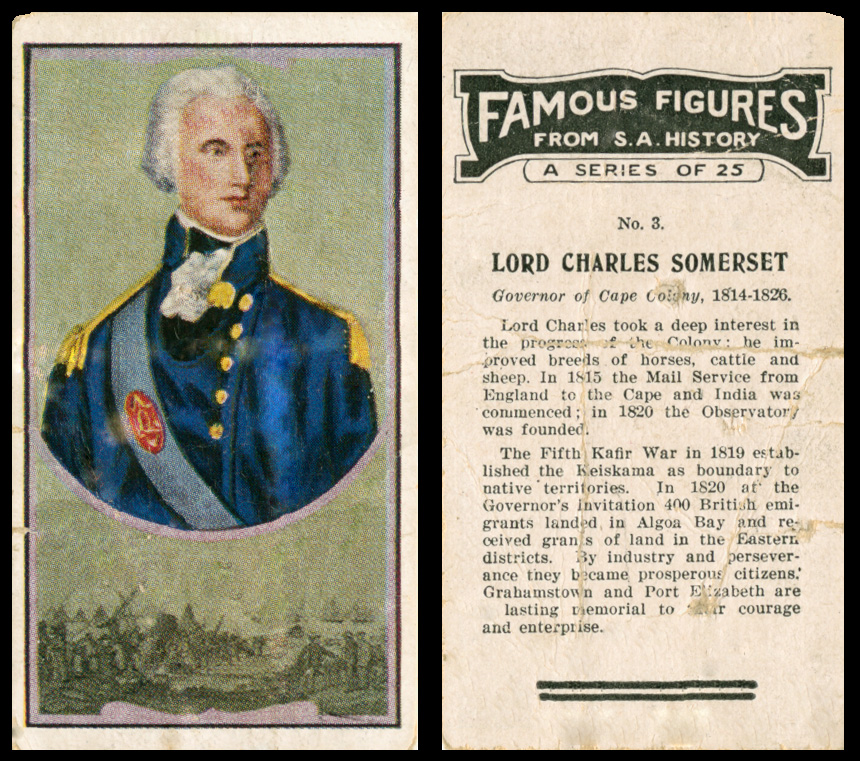
Circa. 1940. Cigarette Card. Lord Charles Somerset, Governor of the Cape, 1814 - 1826.
The following cover has little to do with the 'Hottentot's Holland' but everything to do with the Governor of the Cape of Good Hope in 1823, very much the time that Somerset West came into being in the district of Stellenbosch, (Hottentot's Holland).
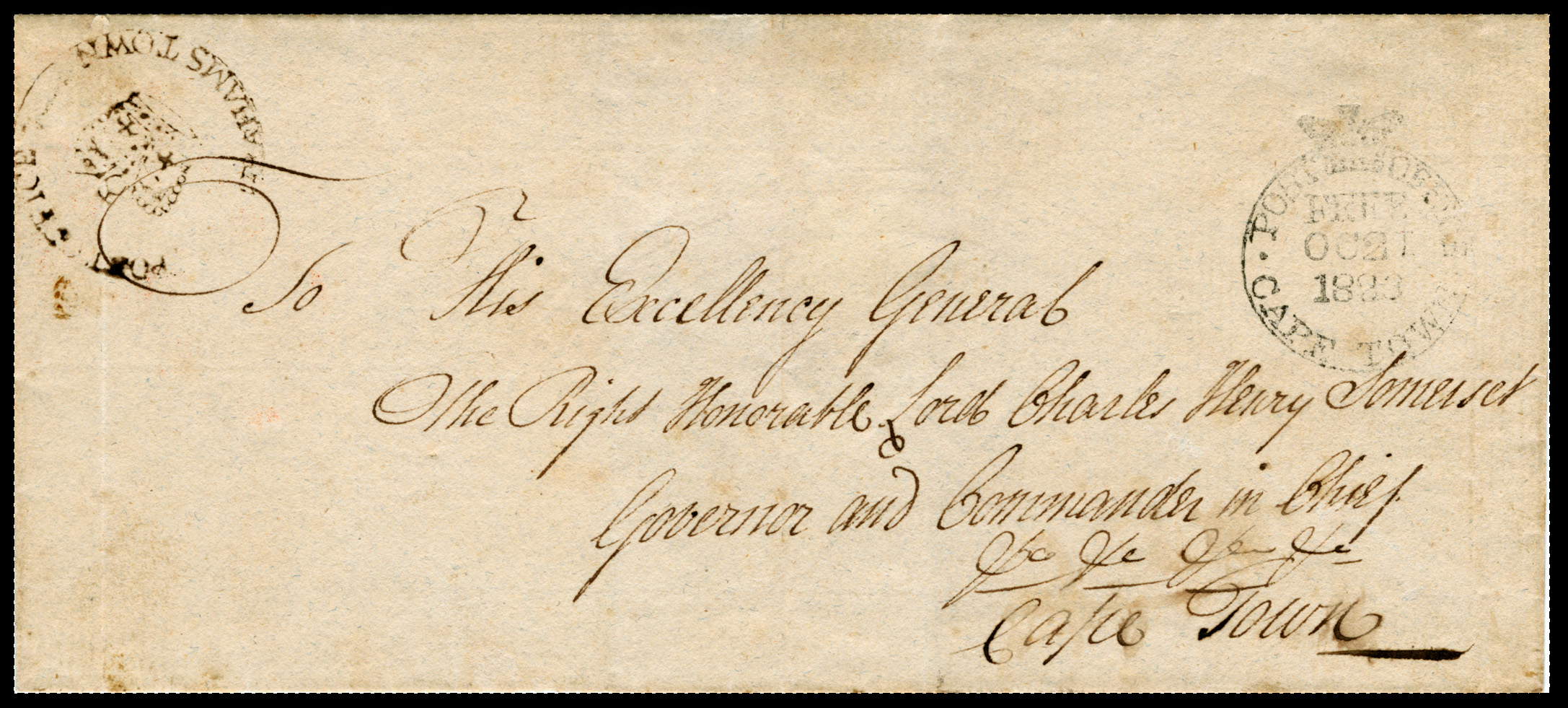
1823. Cover. GRAHAMSTOWN (large CiC handstamp) to CAPE TOWN 'OC 31 1823'.
As this is official and addressed to the Governor, it has been accepted as 'FREE' of charge.
It has received an early, sharp strike of the first 'FREE' datestamp (intoduced 1823).
